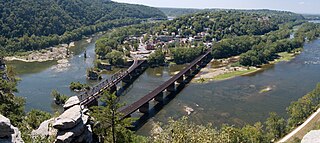
Harpers Ferry National Historical Park, originally Harpers Ferry National Monument, is located at the confluence of the Potomac and Shenandoah rivers in and around Harpers Ferry, West Virginia. The park includes the historic center of Harpers Ferry, notable as a key 19th-century industrial area and as the scene of John Brown's failed abolitionist uprising. It contains the most visited historic site in the state of West Virginia, John Brown's Fort.
Williston is an unincorporated town and census-designated place on the Eastern Shore of the U.S. state of Maryland, in Caroline County. As of the 2010 census it had a population of 155. It is situated between Maryland Route 16 on its eastern edge and the Choptank River on its west. It was originally known as Potter's Landing for its first resident, Zabdiel Potter. His home, Potter Hall, was listed on the National Register of Historic Places in 1982.

The Pikesville Armory was built in 1903 to support the expansion of the National Guard program. The second-oldest armory in Maryland, it was designed by architects Wyatt and Nolting.

The Centreville Armory in Centreville, Maryland, is part of a series of Maryland National Guard armories built in the 1920s in principal towns in Maryland. The armories followed a standard design with a castle-like front housing offices and meeting spaces, backed by a large drill hall.

The Hyattsville Armory is a historic National Guard armory built in 1918 and located in Hyattsville, Prince George's County, Maryland, United States. It was the first Armory built in Prince George's County and the fifth in Maryland. Its architect, Robert Lawrence Harris, served as State Architect under Governor Albert C. Ritchie. In this capacity, Harris supervised the design of similar armories in Salisbury, Kensington, Silver Spring, Hagerstown, Laurel, Easton, Crisfield, Pocomoke City, Centreville, and Cumberland. The structure is distinctly fortresslike and offers a commanding view of the surrounding area. The building is patterned after a medieval English castle and built of native stone, with rectangular turrets flanking the arched limestone entranceway. Carved above the entry is the State Seal of Maryland.
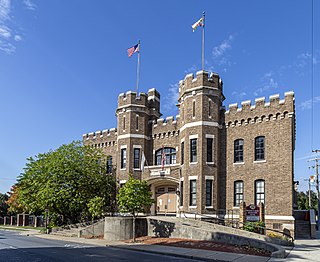
The Frederick Armory is one of a series of similar armories built for the Maryland National Guard in the early 20th century. The building explicitly copies features of medieval fortifications, with crenelated blocks at either end of a buttressed drill hall.

The St. Paul's Episcopal Church is an historic Episcopal church located at Hillsboro, Caroline County, Maryland. It is a small board-and-batten Carpenter Gothic-style structure set on a brick foundation. Its design is based upon a book of plans and sketches published in 1852 by Richard Upjohn.
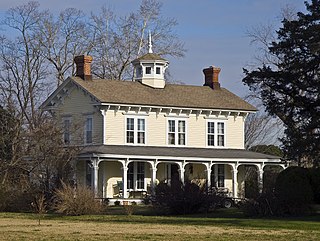
Memory Lane is a historic home located at Denton, Caroline County, Maryland. It a 2+1⁄2-story, frame Italianate-style house constructed in 1864. Notable exterior features include extensive porches, decorative brackets, and an octagonal cupola. The entire front facade features a wraparound porch.
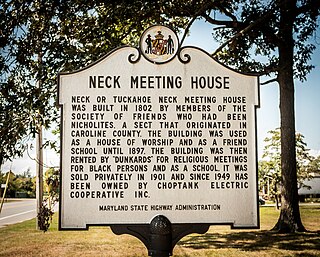
The Neck Meetinghouse and Yard, also known as the Quaker Meetinghouse and Graveyard, is a historic Quaker meetinghouse located at West Denton, Caroline County, Maryland. It is a one-story rectangular frame building with a pitched gable roof measuring 30 feet, 81⁄2 inches long and 20 feet, 5 inches deep. In the graveyard are six marked burials with stones dating from the 1850s to 1890, with some more recent interments. It is the only extant Friends meeting house in Caroline County, and one of only a few still standing on the Eastern Shore. The meeting house was utilized from September 26, 1802, when the first meeting was held in the building, until it was abandoned in 1890 for lack of funds and participants.

The Denton Schoolhouse is a historic school located at Denton, Caroline County, Maryland, United States. It is a small building with a Latin cross plan and several features of the Gothic Revival style, built about 1883. On the roof ridge is an octagonal cupola with a belfry of alternating louvered and plain drop-arched panels, with a cut wooden spire on top.
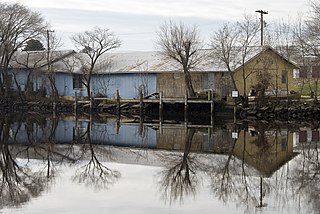
West Denton Warehouse-Wharf is a historic warehouse located at West Denton, Caroline County, Maryland. It is an early-20th century timber-framed warehouse structure situated along the west bank of the upper Choptank River. The earliest section was built about 1850, and is the 40 foot x 100 foot center portion. The north and south additions were built in the 1940s. It is a representative example of a type of structure which served various functions in connection with waterborne commerce, and is one of only two remaining riverfront warehouses in Maryland.

Denton Historic District is a national historic district in Denton, Caroline County, Maryland, United States. It is located on the flat land along the south bank of the Choptank River. The west end of the district focuses on the courthouse square, which was laid out in the 1790s, with its late 19th century courthouse building and square faced on all sides by noteworthy residences and commercial structures. The historic commercial district extends east of the square along Market Street. It comprises a notable collection of two-story brick storefronts and one-story concrete block commercial structures, with frame residences representing late-19th / early-20th century forms interspersed among them.

Williston Mill Historic District is a national historic district in Denton, Caroline County, Maryland, in the United States. It consists of two historic structures—a grist mill and a miller's house—which share the acreage with the mill stream and race that empties into Mill Creek, a tributary of the Choptank River. The Williston miller's house is a two-story, four-bay single-pile frame dwelling, built originally between 1840 and 1850 with later 19th century expansions. The mill building dates from around 1830–1840, with the two-story section built around 1895. It is one of two grist mills that remain standing in Caroline County.

Hagerstown Armory is a historic armory located at 328 N. Potomac Street in Hagerstown, Washington County, Maryland, United States. It is a two-story Flemish bond brick structure with full basement emulating a Medieval fortification, built in 1926. The front facade features a central block offset by two, three-story towers. Tower tops are characterized by a ring of scalloped stone molding, surmounted by a ring of brick dentils, and topped by two crenelles per side with stone caps. The center section is topped by two crenelles with stone caps with stone tablet bearing the seal of the State of Maryland centered between them.

Towson Academy is a historic National Guard armory building located at Towson, Baltimore County, Maryland. It is a two-story brick structure constructed in 1933 with full basement, faced with a smooth light-colored, marble-like stone veneer. It features a T-shaped plan with a two-story front "head house" section and a one-story perpendicular "drill hall" extending to the rear and its façade is detailed to recall Medieval fortifications, with towers flanking the central entrance.
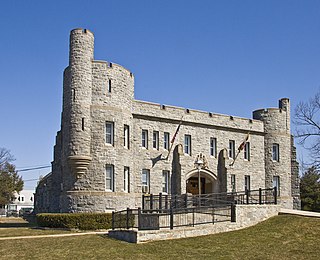
Elkton Armory is a historic National Guard armory located at Elkton, Cecil County, Maryland. It was constructed in 1915 and is a two-story brick structure with full basement faced with light gray granite, with a narrower one-story drill hall attached. Its design imitates a castle, with corner towers flanking two-story curtain walls with irregular window placement. The front facade features a projecting center gate, flanked by buttresses, with a carved relief of the State Seal of Maryland above the entry.

Bel Air Armory is a historic National Guard armory located at Bel Air, Harford County, Maryland. It was constructed in 1915 of Port Deposit granite. The building consists of the main block, five bays by three, two stories over a raised basement, and the "drill hall" to the rear of the main block. The front elevation is detailed to recall Medieval fortifications and features two projecting hexagonal towers which rise to three stories and are topped by crenelated battlements finished in stone coping.

The Crisfield Armory is a historic National Guard armory located at Crisfield, Somerset County, Maryland, United States. It is two stories tall with a full basement, emulates a Medieval fortification, and was built in 1927. Attached to the rear of this two-story main block is a narrower one-story drill hall. The front features a central section flanked by two, three-story tall towers. The State Seal of Maryland appears in a large square stone panel at the roofline, surmounted by three crenelles with stone caps. It is located within the boundaries of the Crisfield Historic District.

The Maggie Lee is a Chesapeake Bay skipjack, built in 1903 at Pocomoke City, Maryland. She is a 51' long two-sail bateau, or "V"-bottomed deadrise type of centerboard sloop. She has a beam of 16', a depth of 3.8', and a net tonnage of 8 register tons. She is one of the 35 surviving traditional Chesapeake Bay skipjacks and a member of the last commercial sailing fleet in the United States. She is located at Denton, Caroline County, Maryland.

The Fifth Regiment Armory is a historic National Guard armory built in Baltimore, Maryland, United States in 1901. It is an imposing, fortress-type structure situated in midtown Baltimore. It consists of a full basement, a first floor containing a 200 foot by 300 foot drill hall, a mezzanine or "balcony" level, and a newer second level housing the trussed steel drill hall roof. The façade features buttresses, parapets, casement windows, and a crenellated roofline, giving the appearance of a medieval fortification. It was the site of the 1912 Democratic National Convention.























